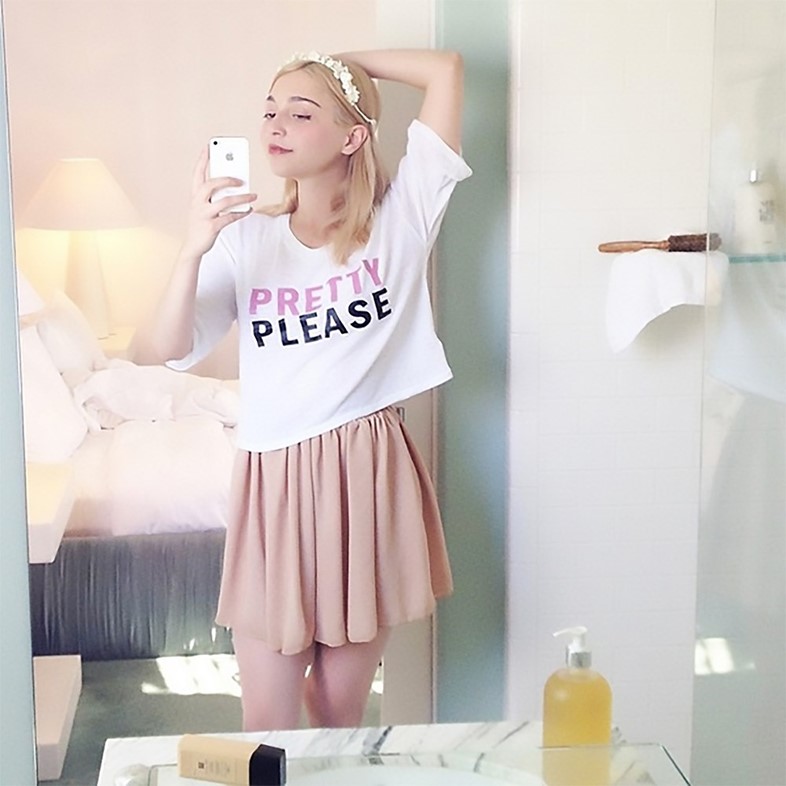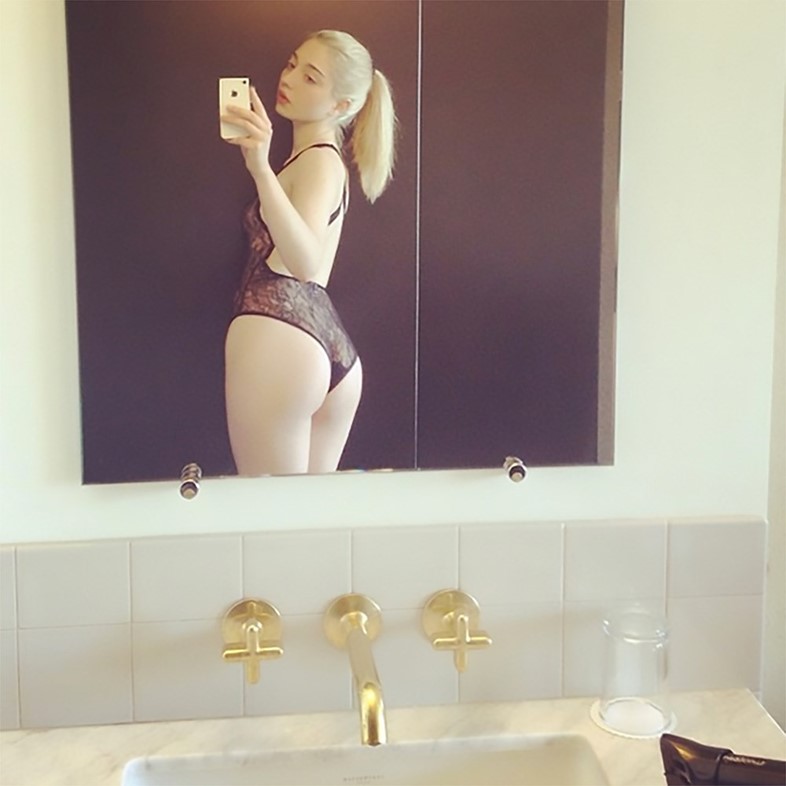From bathroom booty shots to a personal reinvention, a new exhibition explores how Amalia Ulman's take on Instagram tropes has held the digital sphere captivated
As Tate Modern's new exhibition of the same name shows, people have been performing for the camera since the birth of photography, to such an extent that it has played an integral role in the development of performance art. On display in the collection are examples from the 19th century, all the way through some of the major works of the 20th century, to the present day. There's the photo of Yves Klein's famous leap into the void (complete with images showing the nuts and bolts of the work's construction, including the people on the street waiting to catch him); Yayoi Kusama dancing nude, covered in paint spots and merging with paint-spattered walls; Cindy Sherman's iconic Untitled Film Stills, and posters of Joseph Beuys as a kind of proto-art star, among other seminal pieces. While sometimes the camera is used to capture a brief moment in time, sometimes it is used to tell a story over time.
More recently, it has of course been used to capture the performance we are all engaged in, to one degree or another, on social media. The exhibition closes with a trio of photographs by the Spanish-born, LA-based artist Amalia Ulman, taken from her Instagram artwork Excellences & Perfections. The story of this work is by now famous: over four months in 2014, she constructed a compelling ruse via her Instagram feed, a narrative told over a series of images and hashtags about a girl called Amalia who moves to LA, has plastic surgery, develops a habit and then converts to healthy living, adopting a whole new identity in the fiction of this constructed timeline. With her slightly off-kilter take on the so-called Instagram Babe, Ulman attracted almost 90,000 followers, many of whom felt betrayed when they realised it was all a fabrication. Displayed in a room "dealing with the boundary of unreality and fantasy", according to curator Simon Baker, Ulman's photos show her fictionalised character taking a booty shot in the mirror, posing in a hotel room, and staring into her phone in an elevator while holding voluminous shopping bags and wearing an expression of coy modesty.

Ulman is currently showing work in two major London institutions: in addition to the Tate show, work from the same series is being shown at the Whitechapel Gallery as part of the exhibition Electronic Superhighway. Here, the artist of the moment, recently hand-picked by Alessandro Michele to interpret Gucci's #GGBlooms print for its GucciGram project, reveals her working process and the importance of disconnecting in order to make her work.
On detaching yourself from your fictional self…
"That's part of acting, of taking on other characters – of course there's a part of you in them, but I feel detached from them. I do have memories of things that were happening at the time when I was taking the photos but they're unrelated to the photographs themselves. They're meaningful to me, but for the audience, they wouldn't mean anything. That's very important for this kind of work, because it was supposed to be a fiction, and not like a masturbatory tool, or a very personal selfie or anything, but more like an exploration of fiction on social media. I get the inspiration to make works from things that happen in my life but then it takes some sort of digestion for the idea to crystallise and become a thing in itself."
On digital ownership…
"I'm from a generation that has grown up knowing that anything you post online is not yours any more. The re-appropriation of images is a constant thing. I've gotten very used to seeing my work out there, uncredited. Let's say a photo gets saved by someone and they put it on Tumblr and it gets eternal notes – notes and notes and notes, without crediting the person who made the image. It's interesting to see these things like living creatures. Once they leave, they have a life of their own. I always say that anything I text, sext or upload, I wouldn't mind seeing on a billboard. Once it's released you have no control over it. I'm used to it and it doesn't really bother me."
On the need for loneliness...
"I guess I was lonely when I was growing up in the north of Spain and that's how it started. Now I force that loneliness upon myself to be able to work. I need to be 100 percent lonely for two or three days [to be able to] go into some sort of place where I can start making things. Most of these images [develop over] a period of three days in a hotel – they're not like a planned setup during one hour. Really getting into the character allows for the images to be more real in a way, because even though they're not lived experiences, they become like mini-lived experiences, in a sense. It's not like I arrange everything for the photo and then I get on with my life. I make those moments real for at least 24 hours and perform during those days and then the material comes out of that."
On working with Gucci...
"It was very interesting for me because Gucci was already in the mood board for something I'm working on, so it was very good timing. I'm very interested in mixing straightforward branding with art in, I guess, a very Warholian way, re-appropriating the branding into the work, like name dropping brands in a poem or including a logo in a print that will later go in a museum, for example."
On performing sexuality...
"[Excellences and Perfections] is less to do with online presences, and more about women performing their sexuality and their femininity but not really being able to say they're performing. Like, being an escort and faking being in love and not being allowed to say: Look you're paying me, you're old, I'm obviously not in love with you! It's like this constant play. For example, to create those images, or to be an Instagram babe, [you need] to go to the gym a lot and build your booty or have surgery, really invest a lot of time and money on it. But you're not really allowed to reveal the process. Everything has to be natural and low key."
On being included in Performing for the Camera...
"I really love the pieces exhibited here. It's good to be included in this kind of exhibition which is more about performance art and photography than internet art. That's really refreshing. Being included with Cindy Sherman and Hannah Wilke is amazing and I'm very happy that the Jeff Koons photographs are here, including my favourite, the one of him as a school teacher with some kids. And then, Martin Parr, who I know because I used to shelve a lot of his books when I was a librarian at Central St. Martin's, [the work is] very familiar to me. Such iconic artworks, it's really nice."
Performing for the Camera runs until June 12, 2016 at Tate Modern. To celebrate the exhibition, AnOther and Tate have joined forces for a special, ongoing Pinterest collaboration. See more here.
